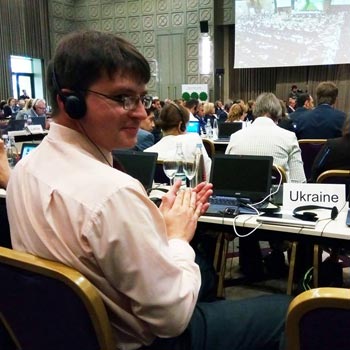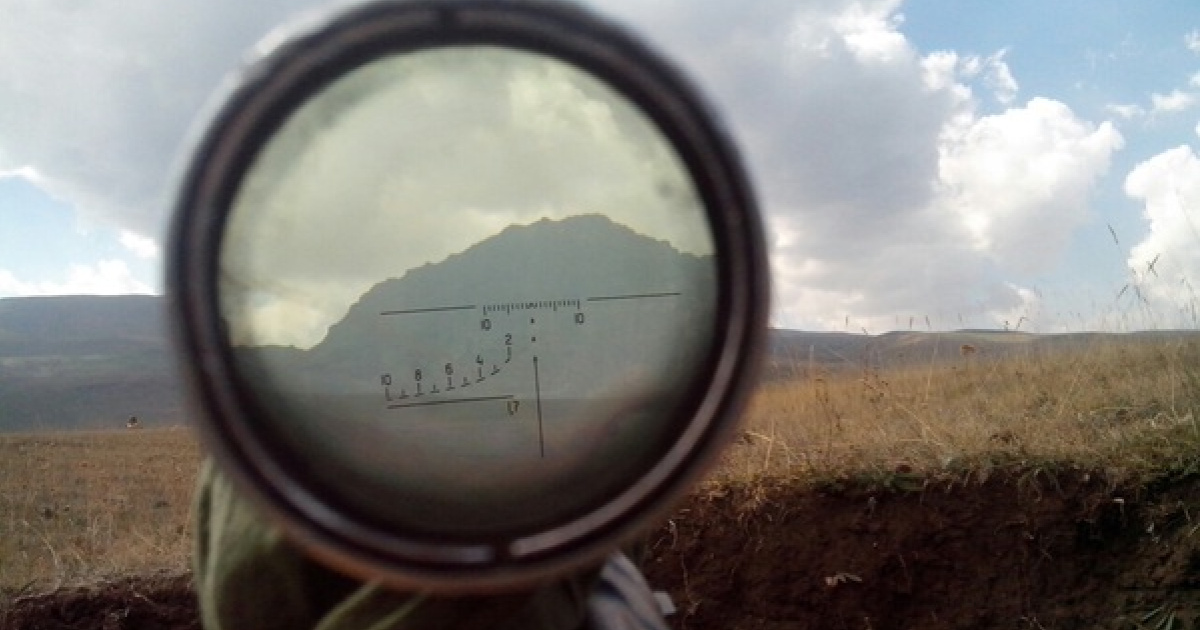"The industrial development of Donbass has led to serious environmental problems: the Donetsk oblast is ranked one of the first in Europe and the first in Ukraine in terms of the level of environmental degradation. The territory of the region turned out to be almost completely involved in economic turnover in the course of industrialization. In 1991, the nature reserve fund of the Donetsk oblast was only 0.6% of its territory (under European criteria of not less than 5%)", - this is how the Russian edition of the online encyclopedia Wikipedia describes the ecological situation in the Donetsk oblast.
Since the beginning of the military conflict, the situation has worsened in the region. Many large industrial enterprises and mines were stopped and the issue of environmental safety was put on the back burner. The consequences of military actions and ill-conceived shutdown of plants will not be felt immediately, but they can provoke a real ecological catastrophe that will affect the entire territory of the Donbass. And not only the Donbass...
In early May 2017, the Cabinet had an interdepartmental meeting on the problems of the Donbass ecology, technogenic and environmental risks caused by armed aggression of the Russian Federation. According to its results, the Verkhovna Rada vice-speaker Iryna Herashchenko stated that "we must increase the world's attention to environmental challenges and problems, demand access of international experts to all enterprises with dangerous production in the temporarily occupied territories, which today are seized by the invaders and militants".
According to her, Ukrainian negotiators in Minsk repeatedly raised the issue of the ceasefire for carrying out repair and restoration works at the enterprises located near the line of demarcation.
"However, the Russia and the “LDPR” do not give any guarantees and opportunities to carry out these works properly. The Torez phenolic plant, the Avdiivka coke plant and other strategic and infrastructure facilities are particularly acute", - the vice-speaker said.
The Ukrainian side of the Center for the Control and Coordination of Ceasefire Issues also states that the management of the “LDPR” is not interested in ensuring the environmental safety of the region.
"Despite the numerous appeals of the Ukrainian side for assisting in providing security guarantees during the implementation of repair and restoration works at critical civil infrastructure facilities near the line of delineation, the Russian-controlled militants systematically block the solutions to these issues", - the Center for the Control and Coordination of Ceasefire Issues declared.
 Ecologist, expert of Zoї Environment Network Dmytro Averin told OstroV about the main ecological threats in the occupied territories of Donbass.
Ecologist, expert of Zoї Environment Network Dmytro Averin told OstroV about the main ecological threats in the occupied territories of Donbass.
- Does the war in the Donbass influence the region's ecology?
- Any military conflict has a serious impact on the environmental security of the region in which it occurs. The combat operations cause the greatest ecological damage in industrial areas, such as Donetsk and Luhansk oblasts. We must understand that the Donbass is the most technologically loaded region of Ukraine and Europe. For example, according to statistical data for 2013, the amount of Donbass atmospheric emissions from stationary sources was 44% of total emissions in Ukraine.
The fighting in the east affects virtually all the components of the environment, from air to underground and surface water sources, soils, landscapes, agricultural lands, objects of nature reserves and so on. The natural environment receives pollution as a result of both direct impact from combat operations and indirect effects, for example, in the event of interruptions in the operation of large industrial enterprises, disruption of the operation of critical infrastructure facilities.
- Before the military conflict, the ecological situation in the region was controlled?
- Yes, the situation was more or less under control. Of course, the natural resources of the Donbass have been in operation for more than two hundred years, a large number of environmentally hazardous enterprises are concentrated there, so the problems were very serious. But before the conflict it was possible at least to keep the situation under control.
- What dangerous industries are currently concentrated in the Donbass?
- First of all, metallurgy, coke chemistry, energy and mining. There are several large metallurgical enterprises, which, one way or another, were damaged as a result of the conflict. These are Makiivka, Donetsk and Yenakiyeve metallurgical plants, Alchevsk Iron and Steel Works... In addition, there are the largest in Ukraine coke-chemical enterprises - Avdiivka Coke Plant, which stopped several times as a result of infrastructure damage and power outages, Makiivka, Yasynivsky, Yenakiyeve and Alchevsk Coke plants, which were also significantly damaged from shelling.
As a result of the fighting, the equipment of Luhansk, Sloviansk, Vyhlehirsk and Myronivka thermal power plants was damaged, and there were interruptions in the work of the Starobishevska, Kurakhivska and Zuivska TPPs. The enterprises of the chemical industry - the Lysychansk oil refinery, the Donetsk state chemical plant, Severodonetsk’s Azot and Horlivka’s Stirol also suffered damage. The coal mining enterprises, which are the most vulnerable during the fighting, also constitute a great ecological danger, since they need uninterrupted power supply.
- What are the dangers of damage to such large enterprises?
- An emergency violation of the operation of large industrial enterprises, in my opinion, can have the most dangerous and difficult impacts on the environment of the region. As a result of the destruction of the production infrastructure and emergency shutdowns of enterprises, the risks of such impacts are significantly increasing. Combat actions affect the organization of the work of enterprises, as the work of treatment facilities is disrupted, the processes of supplying enterprises and their technological regimes change drastically. Because of accidental emissions, the pollution of atmospheric air, surface, groundwater and soils occurs. Explosions can lead to hazardous effects on the people who live near the enterprises.
For example, in 2015, as a result, of shelling of the Avdiivka coke plant, a fire and a leak of coke gas occurred. All four high-voltage lines that powered the enterprise were down, a volley of coke gas emission with a high content of benzene, hydrogen sulfide and ammonia occurred. Many are aware of the situation with the Dzerzhynsky phenol plant and its tailing, which is located almost on the line of demarcation. In case of the dam destruction, liquid chemical waste can get to the Siverskyi Donets river and further - to the Sea of Azov.
The Azovstal Iron and Steel Works is also situated near the line of demarcation. Its shops and other premises are located on the coast of the Sea of Azov. In case of the dam damage, which separates the waters of the Sea of Azov from the slag storage, ash storage of the TPP and slag dump, an ecological catastrophe is inevitable. The hazardous waste burials on the territory of the former Horlivka Chemical Plant also cause concern.
One of the main environmental problems of Donbass is the flooding of coal mines due to the lack of water drainage, especially in the Horlivka area. This leads to a change in the regime of groundwater and entails a number of negative environmental consequences. Waterlogging and salinization of soils are not excluded, since mine waters in the Donbass are highly mineralized. Salinization of soils leads to their withdrawal from economic exploitation, the mineralization and radioactivity of groundwater and surface water increases, and so on. In addition, flooding provokes subsidence processes, which can lead to a violation of the integrity of tailings and the destruction of land-based facilities, including ecologically dangerous ones.
- Why are the mines flooded?
- At enterprises, because of a violation of the normal operating mode, emergency shutdown of power supply, destruction of buildings or pumping equipment, pumping of mine waters is suspended. In addition, some of the damaged or stopped mines in the Donbass are dismantled, the equipment is cut to metal without any environmental impact assessment.
- Is there an approximate number of mines that have already been flooded?
- Unfortunately, the exact number of such mines is unknown. More than 20 mines are under the threat of flooding, or are already completely flooded and are not subject to further exploitation. Drainage does not work practically on all territory from Horlivka to Zolote.
- How soon will the local population of Donbass feel negative environmental consequences?
- Certain changes are already visible. In particular, the water content of rivers in the Donetsk oblast has increased, which may indicate an increase in the level of groundwater, which is fed by the mine waters. This water enters surface water sources without purification, therefore the salt concentration changes, which in turn affects the quality of drinking water supply and the chemical composition of water in the rivers of the region.
Moreover, the rising of underground water causes flooding of territories and driving of methane to the surface, and methane is an explosive gas which can be accumulated in cellars and house entrances, what leads to the negative environmental consequences and occurrence of dangerous situations. Similar phenomena had already appeared in Horlivka in the early 2000s in the area of "Kochegarka" mine.
- The OSCE focuses on the Donetsk Filter Station in these latter days that in case of its destruction an ecological catastrophe may occur. What are the dangers concerning this facility?
- It should be understood that water purification at all filter stations takes place with the help of chlorine - an active substance which is very dangerous both for the population and environment. Therefore, in case of damage to containers with chlorine substances as a result of the armed hostilities, chlorine blowout may occur and, depending on how much substance will be in the storage, the consequences may be different. But, in any case, consequences will be very serious – the pollution of territory from the epicenter of blowout can spread for several kilometers. The main danger caused by the shelling of the filter station is a real humanitarian catastrophe for population of the region, connected with the lack of water supply for tens of thousands of people.
- Is there any danger of radiation increase in the uncontrolled territory of the Donbass?
- Such risks exist. Of course, they cannot be compared with Chernobyl, but there are several facilities in the Donetsk oblast, disturbance of which can lead to radiation poisoning of significant areas. Firstly, it is the "Yunkom" mine in Bunge (formerly - Yunokomunarivsk) where an underground nuclear burst was made in the late 1970s as part of an experiment to reduce tension in the mountain mass. And, since the mine is being flooded now, radiation poisoning of mine waters can occur, what will also affect surface water in the future. Secondly, a RW repository of the USSR Ministry of Defence, the state of which caused concern back in 2000s, is located in the territory of the Donetsk state-owned chemical plant. The situation with the air-tightness of the repository is unknown now, especially given the fact that several powerful explosions occurred in the plant territory in 2014-2015. Furthermore, the mine water itself is characterized by a high content of radionuclides.
- How much this level of radioactivity can be harmful to humans?
- As for mine waters, I think it will be within the limits of the permissible, but talking about these two facilities ("Yunkom" mine and Donetsk state-owned chemical plant), - it is difficult to predict the situation there.
- Are there any problems with drinking water on the uncontrolled territory of the Donbass by now?
- Problems with drinking water in the Donbass began as early as 2014. Firstly, water often does not pass the necessary purification stages and contains pathogenic viruses and bacteria that can cause various types of intestinal infections, especially in warm periods. Secondly, there are constant interruptions with water supply because of the destruction of infrastructure of the Siverskyi Donets-Donbass channel which provides much of the Donetsk oblast with water, pump and filter stations, transmission and distribution networks. For example, Mariupol which received water through the Yuzhnodonbass water conduit before the conflict feels now constant interruptions of water supply from the Siverskyi Donets. The city has to use water from the Starokrymsky reservoir which has very high mineralization and low quality. Thirdly, the quality of drinking water also decreases because of the deteriorating quality of surface water.
- Is it always possible to distinguish drinking water of poor quality?
- Not always. In case of chemical contamination of water, one hardly feels the difference, and radioactive contamination does not change taste, color and smell at all.
- Have those mines that are now being flooded already become unusable for further operation?
- This is true for some cases, but some mines can still be restored. For example, several mines were flooded in Makiivka, but the drainage was restored and now they are being operated. Everything depends on the level of mine flooding, the level of equipment damage and so on.
- How long is the process of saline soils recovery?
- It is difficult to reclamate the soil after salinization. The water table will decrease with the restoration of the mines' drainage, but the process of soil remediation will be long and expensive. Unfortunately, salinization can become irreversible because of the economic inexpediency of reclamation works. It is still possible to minimize the damage to the natural environment of the Donbass, but, if we lose time (almost no attention was paid to the ecological safety in 2014-2015), many of the negative processes taking place there now can become irreversible.
I think that part of the Donbass territory can become uninhabitable within 5-10 years because of the impossibility of economic exploitation. First of all, it will concern those territories that are located near the line of demarcation, the territories in the area of Horlivka, Toretsk, Debaltseve and Zolote, and in case of serious environmental disaster, for example, chemical contamination of the Siverskyi Donets or Kalmius rivers, we can get pollution of the whole Azov Sea water area.
- Is the issue of evacuation of local population from the uncontrolled territory relevant?
- The issue of environmental migration may become relevant in the medium term, unless measures to minimize the environmental consequences of the conflict will be taken right now. The issues of population migration because of the armed hostilities are on the agenda at the moment.
- Are there any risks for the controlled territory of Ukraine?
- Of course, there are significant risks. First of all, this concerns the pollution of the Siverskyi Donets River which is the main drinking artery for the Donetsk and Luhansk oblasts. The Kazennyi Torets and Kryvyi Torets rivers with tributaries join it, and in case of their contamination, we get pollution not only from the Siverskyi Donets and Don, but also from the Sea of Azov. The Kalmius, Mius and Hruzkyi Yalanchyk rivers also join the Sea of Azov. There is also a danger of salinization of irrigated lands not only on the territory of Ukraine, but also on the territory of the Rostov oblast.
- What is being done by the Ukrainian party now to prevent the environmental disaster?
- There was no political willpower to solve environmental problems arising as a result of the conflict in 2014-2015, civilians and military perceive this problem in different ways. Now this topic finally becomes relevant both for the authorities and society. First of all, the Ministry of Temporarily Occupied Territories and Internally Displaced Persons and the Ministry of Ecology and Natural Resources of Ukraine, various international organizations actively work in this direction.
For example, the OSCE Project Coordinator in Ukraine currently works on a project to investigate the damage caused to the environment as a result of the armed conflict in the east of Ukraine at the request of the Ministry of Ecology. This project provides field study of the state of environment, development of ecological safety priorities for the Donetsk and Luhansk oblasts and development of information system for the assessment of environmental risks in the conflict zone. Moreover, the Ministry of Temporary Occupied Territories has established a working group to assess and resolve environmental problems in the east of Ukraine, a draft program for the restoration and development of peace in the eastern regions of Ukraine has been developed, in which environmental protection measures are put in a separate paragraph – this is a very positive signal.
As far as I know, activities on the purchase and installation of automated posts to monitor the quality of atmospheric air on the controlled territory are currently being financed in the Donetsk oblast, what in case of emergency at enterprises, will provide the latest information on the state of atmospheric air. Furthermore, it is planned to install automated posts for surface water quality control in places of water intakes on the Siverskyi Donets River.
The works to restore power and water supply, strengthen levees and so on are constantly being done as well, but not all depends on the Ukrainian party here because it is necessary to coordinate the ceasefire in the JCCC with the Russian party in order to do repair works. However, strategic approach is needed to solve the accumulated ecological problems and minimize the environmental risks.
- What else can be done from the Ukrainian party in order to get things under control?
- It is necessary to significantly increase the financing of the state environmental monitoring system in the Donetsk and Luhansk oblasts, increase the number of observation posts and extend the list of controlled substances in order to obtain the latest information for decision-making. It is necessary to assess the environmental risks and damage to the environment in the east, develop a strategy to minimize the environmental consequences of armed hostilities and begin its implementing.
Even as we speak, it is necessary to undertake a study on the level of mines' flooding in the Donetsk and Luhansk oblasts, define the financing and restoration of drainage, repair of destroyed waste treatment facilities and levees. These are quite costly activities what means hundreds of millions hryvnias.
- I suppose this work requires access to the uncontrolled territories?
- Of course. We still need to find the ways to coordinate efforts for organization of such works in prospect together with international organizations and partners in order to preserve the Donbass. In the meantime, it is needed to start the works on the territories controlled by the government, believe me, there is enough work there.
Interviewed by Vladyslav Bulatchik, OstroV




